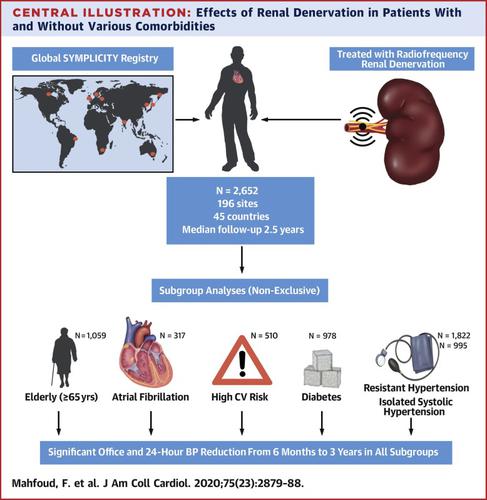当前位置:
X-MOL 学术
›
J. Am. Coll. Cardiol.
›
论文详情
Our official English website, www.x-mol.net, welcomes your feedback! (Note: you will need to create a separate account there.)
Renal Denervation in High-Risk Patients With Hypertension
Journal of the American College of Cardiology ( IF 24.0 ) Pub Date : 2020-06-01 , DOI: 10.1016/j.jacc.2020.04.036 Felix Mahfoud 1 , Giuseppe Mancia 2 , Roland Schmieder 3 , Krzysztof Narkiewicz 4 , Luis Ruilope 5 , Markus Schlaich 6 , Robert Whitbourn 7 , Andreas Zirlik 8 , Thomas Zeller 9 , Philipp Stawowy 10 , Sidney A Cohen 11 , Martin Fahy 12 , Michael Böhm 1
Journal of the American College of Cardiology ( IF 24.0 ) Pub Date : 2020-06-01 , DOI: 10.1016/j.jacc.2020.04.036 Felix Mahfoud 1 , Giuseppe Mancia 2 , Roland Schmieder 3 , Krzysztof Narkiewicz 4 , Luis Ruilope 5 , Markus Schlaich 6 , Robert Whitbourn 7 , Andreas Zirlik 8 , Thomas Zeller 9 , Philipp Stawowy 10 , Sidney A Cohen 11 , Martin Fahy 12 , Michael Böhm 1
Affiliation

|
BACKGROUND
Renal denervation (RDN) is under investigation for treatment of uncontrolled hypertension and might represent an attractive treatment for patients with high cardiovascular (CV) risk. It is important to determine whether baseline CV risk affects the efficacy of RDN. OBJECTIVES
The purpose of this study was to assess blood pressure (BP) reduction and event rates after RDN in patients with various comorbidities, testing the hypothesis that RDN is effective and durable in these high-risk populations. METHODS
BP reduction and adverse events over 3 years were evaluated for several high-risk subgroups in the GSR (Global proSpective registrY for syMPathetic renaL denervatIon in seleCted IndicatIons Through 3 Years Registry), an international registry of RDN in patients with uncontrolled hypertension (n = 2,652). Comparisons were made for patients age ≥65 years versus age <65 years, with versus without isolated systolic hypertension, with versus without atrial fibrillation, and with versus without diabetes mellitus. Baseline cardiovascular risk was estimated using the American Heart Association (AHA)/American College of Cardiology (ACC) atherosclerosis cardiovascular disease (ASCVD) risk score. RESULTS
Reduction in 24-h systolic BP at 3 years was -8.9 ± 20.1 mm Hg for the overall cohort, and for high-risk subgroups, BP reduction was -10.4 ± 21.0 mm Hg for resistant hypertension, -8.7 ± 17.4 mm Hg in patients age ≥65 years, -10.2 ± 17.9 mm Hg in patients with diabetes, -8.6 ± 18.7 mm Hg in isolated systolic hypertension, -10.1 ± 20.3 mm Hg in chronic kidney disease, and -10.0 ± 19.1 mm Hg in atrial fibrillation (p < 0.0001 compared with baseline for all). BP reduction in patients with measurements at 6, 12, 24, and 36 months showed similar reductions in office and 24-h BP for patients with varying baseline ASCVD risk scores, which was sustained to 3 years. Adverse event rates at 3 years were higher for patients with higher baseline CV risk. CONCLUSIONS
BP reduction after RDN was similar for patients with varying high-risk comorbidities and across the range of ASCVD risk scores. The impact of baseline risk on clinical event reduction by RDN-induced BP changes could be evaluated in further studies. (Global proSpective registrY for syMPathetic renaL denervatIon in seleCted IndicatIons Through 3 Years Registry; NCT01534299).
中文翻译:

高血压高危患者的肾脏去神经支配
背景 去肾神经支配 (RDN) 正在研究用于治疗不受控制的高血压,并且可能代表具有高心血管 (CV) 风险的患者的有吸引力的治疗方法。确定基线 CV 风险是否影响 RDN 的功效很重要。目的 本研究的目的是评估 RDN 后各种合并症患者的血压 (BP) 降低和事件发生率,检验 RDN 在这些高危人群中有效且持久的假设。方法 对 GSR 中几个高风险亚组的 3 年内血压降低和不良事件进行了评估(全球前瞻性注册在选定的适应症中通过 3 年注册进行交感性肾去神经支配),这是一个针对未控制高血压患者的 RDN 国际注册(n = 2,652)。对年龄≥65 岁与年龄<65 岁、伴与不伴单纯收缩期高血压、伴与不伴心房颤动以及伴与不伴糖尿病的患者进行比较。使用美国心脏协会 (AHA)/美国心脏病学会 (ACC) 动脉粥样硬化心血管疾病 (ASCVD) 风险评分评估基线心血管风险。结果 整个队列的 3 年 24 小时收缩压降低为 -8.9 ± 20.1 毫米汞柱,对于高危亚组,顽固性高血压的血压降低为 -10.4 ± 21.0 毫米汞柱,在年龄≥65 岁的患者,糖尿病患者为 -10.2 ± 17.9 mmHg,单纯收缩期高血压患者为 -8.6 ± 18.7 mmHg,慢性肾病患者为 -10.1 ± 20.3 mmHg,房颤患者为 -10.0 ± 19.1 mmHg( p < 0。0001 与所有基线相比)。在 6、12、24 和 36 个月时测量的患者血压降低显示,对于基线 ASCVD 风险评分不同的患者,诊室和 24 小时血压降低相似,并持续 3 年。基线 CV 风险较高的患者在 3 年时的不良事件发生率较高。结论 对于具有不同高风险合并症和跨 ASCVD 风险评分范围的患者,RDN 后的血压降低是相似的。可以在进一步的研究中评估基线风险对 RDN 诱导的血压变化对临床事件减少的影响。(全球前瞻性注册在选定的适应症中进行 3 年注册;NCT01534299)。对于基线 ASCVD 风险评分不同的患者,36 个月和 36 个月的诊室血压和 24 小时血压均出现类似降低,并持续了 3 年。基线 CV 风险较高的患者在 3 年时的不良事件发生率较高。结论 对于具有不同高风险合并症和跨 ASCVD 风险评分范围的患者,RDN 后的血压降低是相似的。可以在进一步的研究中评估基线风险对 RDN 诱导的血压变化对临床事件减少的影响。(全球前瞻性注册在选定的适应症中进行 3 年注册;NCT01534299)。对于基线 ASCVD 风险评分不同的患者,36 个月和 36 个月的诊室血压和 24 小时血压显示出类似的降低,并持续了 3 年。基线 CV 风险较高的患者在 3 年时的不良事件发生率较高。结论 对于具有不同高风险合并症和跨 ASCVD 风险评分范围的患者,RDN 后的血压降低是相似的。可以在进一步的研究中评估基线风险对 RDN 诱导的血压变化对临床事件减少的影响。(全球前瞻性注册在选定的适应症中进行 3 年注册;NCT01534299)。结论 对于具有不同高风险合并症和跨 ASCVD 风险评分范围的患者,RDN 后的血压降低是相似的。可以在进一步的研究中评估基线风险对 RDN 诱导的血压变化对临床事件减少的影响。(全球前瞻性注册在选定的适应症中进行 3 年注册;NCT01534299)。结论 对于具有不同高风险合并症和跨 ASCVD 风险评分范围的患者,RDN 后的血压降低是相似的。可以在进一步的研究中评估基线风险对 RDN 诱导的血压变化对临床事件减少的影响。(全球前瞻性注册在选定的适应症中进行 3 年注册;NCT01534299)。
更新日期:2020-06-01
中文翻译:

高血压高危患者的肾脏去神经支配
背景 去肾神经支配 (RDN) 正在研究用于治疗不受控制的高血压,并且可能代表具有高心血管 (CV) 风险的患者的有吸引力的治疗方法。确定基线 CV 风险是否影响 RDN 的功效很重要。目的 本研究的目的是评估 RDN 后各种合并症患者的血压 (BP) 降低和事件发生率,检验 RDN 在这些高危人群中有效且持久的假设。方法 对 GSR 中几个高风险亚组的 3 年内血压降低和不良事件进行了评估(全球前瞻性注册在选定的适应症中通过 3 年注册进行交感性肾去神经支配),这是一个针对未控制高血压患者的 RDN 国际注册(n = 2,652)。对年龄≥65 岁与年龄<65 岁、伴与不伴单纯收缩期高血压、伴与不伴心房颤动以及伴与不伴糖尿病的患者进行比较。使用美国心脏协会 (AHA)/美国心脏病学会 (ACC) 动脉粥样硬化心血管疾病 (ASCVD) 风险评分评估基线心血管风险。结果 整个队列的 3 年 24 小时收缩压降低为 -8.9 ± 20.1 毫米汞柱,对于高危亚组,顽固性高血压的血压降低为 -10.4 ± 21.0 毫米汞柱,在年龄≥65 岁的患者,糖尿病患者为 -10.2 ± 17.9 mmHg,单纯收缩期高血压患者为 -8.6 ± 18.7 mmHg,慢性肾病患者为 -10.1 ± 20.3 mmHg,房颤患者为 -10.0 ± 19.1 mmHg( p < 0。0001 与所有基线相比)。在 6、12、24 和 36 个月时测量的患者血压降低显示,对于基线 ASCVD 风险评分不同的患者,诊室和 24 小时血压降低相似,并持续 3 年。基线 CV 风险较高的患者在 3 年时的不良事件发生率较高。结论 对于具有不同高风险合并症和跨 ASCVD 风险评分范围的患者,RDN 后的血压降低是相似的。可以在进一步的研究中评估基线风险对 RDN 诱导的血压变化对临床事件减少的影响。(全球前瞻性注册在选定的适应症中进行 3 年注册;NCT01534299)。对于基线 ASCVD 风险评分不同的患者,36 个月和 36 个月的诊室血压和 24 小时血压均出现类似降低,并持续了 3 年。基线 CV 风险较高的患者在 3 年时的不良事件发生率较高。结论 对于具有不同高风险合并症和跨 ASCVD 风险评分范围的患者,RDN 后的血压降低是相似的。可以在进一步的研究中评估基线风险对 RDN 诱导的血压变化对临床事件减少的影响。(全球前瞻性注册在选定的适应症中进行 3 年注册;NCT01534299)。对于基线 ASCVD 风险评分不同的患者,36 个月和 36 个月的诊室血压和 24 小时血压显示出类似的降低,并持续了 3 年。基线 CV 风险较高的患者在 3 年时的不良事件发生率较高。结论 对于具有不同高风险合并症和跨 ASCVD 风险评分范围的患者,RDN 后的血压降低是相似的。可以在进一步的研究中评估基线风险对 RDN 诱导的血压变化对临床事件减少的影响。(全球前瞻性注册在选定的适应症中进行 3 年注册;NCT01534299)。结论 对于具有不同高风险合并症和跨 ASCVD 风险评分范围的患者,RDN 后的血压降低是相似的。可以在进一步的研究中评估基线风险对 RDN 诱导的血压变化对临床事件减少的影响。(全球前瞻性注册在选定的适应症中进行 3 年注册;NCT01534299)。结论 对于具有不同高风险合并症和跨 ASCVD 风险评分范围的患者,RDN 后的血压降低是相似的。可以在进一步的研究中评估基线风险对 RDN 诱导的血压变化对临床事件减少的影响。(全球前瞻性注册在选定的适应症中进行 3 年注册;NCT01534299)。


























 京公网安备 11010802027423号
京公网安备 11010802027423号